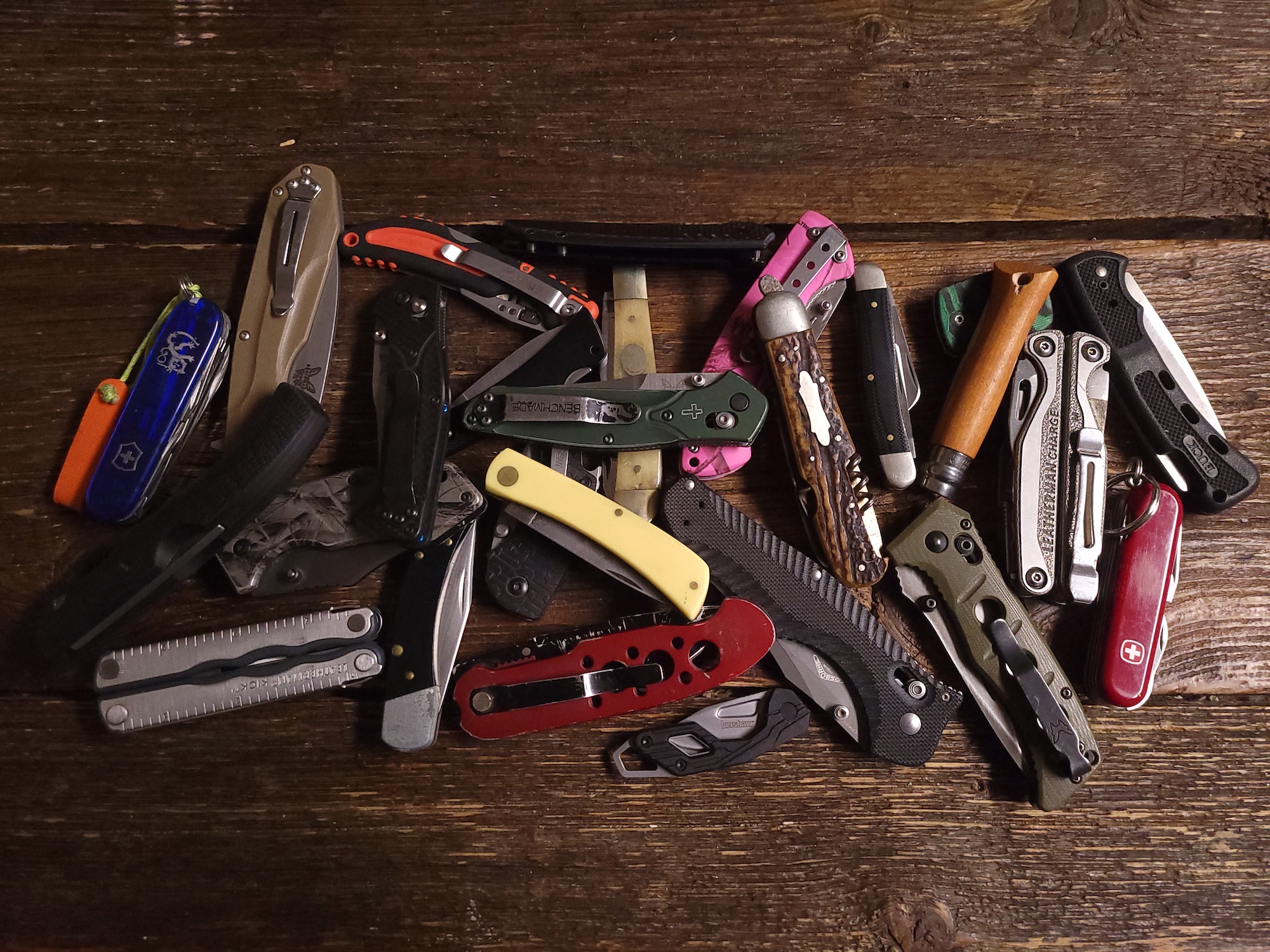We may earn revenue from the products available on this page and participate in affiliate programs. Learn More ›
I’ve been lucky enough to own and handle many of the best pocket knives, including production and custom blades. Now, the Fifth Amendment protects me from self-incrimination, so I won’t say how many knives I currently own, or have owned, because it’s possible that my wife will read this. However, I will say that I have been a prolific purchaser of cutlery since I got my first knife at age 5. I even started a sharpening business years ago just to fund my “hobby.”
If you don’t want a drawer(s) full of knives and just want to find the best pocket knife for you, I’ve put together a list of the best pocket knives for a variety of users and uses. I didn’t randomly pick the following knives out of a hat. I’ve had many knives pass through my hands on the sharpening bench and in my collection, and have learned a lot about what makes a great pocket knife through hands-on experience. Nobody wants second-best anything, so here are my picks for the best pocket knives.
Best Pocket Knives: Reviews and Recommendations
Best Overall: Flytanium Arcade
See It
Key Features
- Blade Length: 3.2 inches
- Overall Length: 7.7 inches
- Weight: 3.2 ounces
- Blade Steel: S35VN
- Deployment Methods: Thumb stud or Shark-Lock tab
- Demko Shark-Lock
- 6061 aluminum scales with G10 or Micarata insert
- Uses ceramic pivot bearings
- Made in Taiwan
- Price: $199
Pros
- Excellent locking mechanism
- Great action
- Top cutting performance
- Customizable (50,000+ configurations)
- Easy to carry
- Ideal blade length-to-weight ratio
- Lefty friendly
Cons
- Not the most exciting blade steel
- Some will prefer G10 slabs or full titanium over the aluminum handles

The Arcade was among the elite cutters in my test and it has one of the strongest lock designs ever made— Andrew Demko’s Shark-Lock. Those features combined with its scant weight, deep carry clip, and fun action propelled it to the Editor’s Choice win.
Flytanium’s Arcade turned in the fastest cut course time by being good at all the cutting tasks rather than exceptional at one. While cutting cardboard head-to-head it held its own against the PM2, but the slicing edge went to the Spyderco. The Arcade excelled at the dowel cut, biting deep into the wood, and the comfortable ergos allowed me to put a lot of force behind the cuts. The blade has a nice straight section for cutting rope and a strong tip for piercing cuts.
I personally think that S35VN is one of the best EDC steels, but I get that it’s not the newest and most exciting option available. I’d guess that as this knife gains in popularity we’ll see it offered in Magnacut or one of the other in-demand steels. More important than the chosen material is that the factory making Arcade has a good heat treat on their S35VN because it didn’t chip or lose sharpness throughout testing.
The ergos are deceptively simple on the Arcade, but they’re well executed. You can choke up for detail cuts and make powerful cuts with the use of the aggressive jimping. In the oak dowel phase there was only slight discomfort around the grip’s edges, but nothing so harsh that I’d call it a hot spot.
The Arcade I used for the test is my personal knife, so it’s seen a lot of pocket time. I’ve found it to be one of the nicest full-sized knives for EDC. It sits deep in the pocket and I barely notice it. One area it could be improved is a little more clip tension for more security with thinner pants materials.
I’ve also tested Flytanium’s customer service. When I got my knife, it would click when pressure was applied to the spine. I emailed Flytanium who promptly sent me a shipping label and returned my knife back to me within a week in perfect working order. The customer service person I emailed with was kind and helpful throughout the whole process.
Also Consider: Where’s the Demko AD20.5? I own an AD20.5 and carry it often. I tested it and it was one of the knives that did great, but ultimately came up just short of making the final cut. If you want a knife that has the Shark-Lock, but is more hard-use oriented than the Arcade, the AD20.5 is a fantastic option. I’d also take a look at Demko’s new slicer grind options and smaller Shark Cub.
Read Next: Best Fixed Blade Knives
Best for $100: WE Banter

See It
The WE Banter was one of the most surprising successes of the entire test. The knife doesn’t look like much—a simple blade and handle design. But when I hit its thumb stud I was immediately impressed by its satisfying action. Then I was blown away at how it chewed through the oak dowel quickly, and it did so without inducing even the slightest hot spot. That performance shook up my expectations of what a small knife can do.
The action though, is really something special. It has that premium knife feel and an audible click as the blade locks open that is oh so sweet. You can easily pay three times the price of a Banter for the same experience. Like the Arcade, it wasn’t the top finisher at any one phase of the cut test, but very good at all of them. If you have a $100 budget, this is one of the best EDC knife options out there.
Also Consider: WE’s more affordable brand, Civivi, makes a Banter model that’s around $50. It’s the same design with budget materials.
Best Budget: Civivi Qubit

See It
Key Features
- Blade Length: 2.98 inches
- Overall Length: 7.19 inches
- Weight: 2.82 ounces
- Blade Steel: 14C28N
- Deployment Method: Thumb stud
- Button lock
- Aluminum handles
- Made in China
- Price: $60
Pros
- Lefty friendly
- Great slicer
- Snappy action
Cons
- Finger choil is a little too small

I tested so many great knives under $100 that I’m compelled to write a dedicated review on them. One that stood out in that impressive crowd was the Qubit. It out-cut all the others with its thin blade geometry and the nicely sculpted aluminum handles were comfortable during the toughest cuts. The Qubit’s biggest competition was the CJRB Pyrite. They’re both button locks with nice snappy actions. But the Qubit cut slightly better and lacked the Pyrite’s hotspots during heavy cutting.
Best Slipjoint: QSP Hedgehog
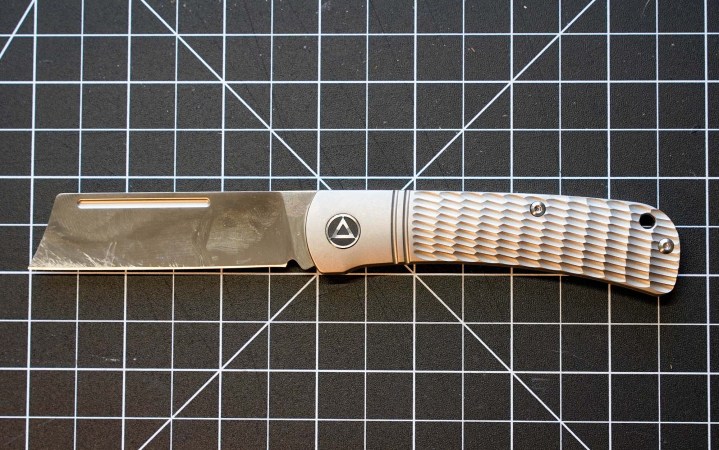
See It
Key Features
- Blade Length: 2.875 inches
- Overall Length: 6.6 inches
- Weight: 2.7 ounces
- Deployment Methods: Nail nick and blade pinch
- Blade Material: M390
- Titanium or carbon fiber covers
- Price: $145 (titanium) or $85 (carbon)
Pros
- Light and easy to carry
- Deep hollow grind makes for a slicey blade
- Great walk and talk
- Good fit and finish
Cons
- Some slipjoint enthusiasts will prefer a more traditional pattern

I went from a slipjoint curious collector to carrying one daily, and among my pocket regulars is the excellent QSP Hedgehog.
The sheepsfoot blade is easy to pinch and I’d judge the pull strength at a 6—slightly more than a Swiss Army Knife. It snaps into the half stop and then again into the open position. The walk and talk on the Hedgehog is a treat and while different from my Jack Wolf and Northwoods knives, is no less satisfying. It has a very unique sound, especially when opening to the half stop.
The blade is tall and features a deep hollow grind, which makes it an incredible slicer. It’s one of the most fun knives to cut with and it passes through rope, cardboard, and plastic with very little resistance.
Best Ultralight: Benchmade Bugout 535-3
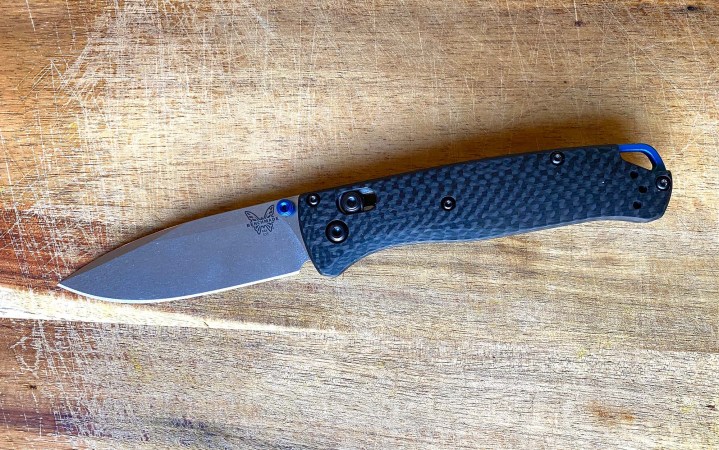
See It
Key Features
- Blade Length: 3.25 inches
- Steel: S90V
- Handle: Carbon fiber
- Weight: 2 ounces
- Lock: Axis
- Price: $298
Pros
- Great edge retention
- Extremely light
Cons
- Some fit and finish flaws
The Benchmade Bugout comes in several trim levels, ranging in price from $160 to $540. The price fluctuates with the materials. If you want a super steel and carbon fiber, it’s going to cost you. But, all the models share the same blade shape, ergonomics, and locking mechanism.
The Bugout has a drop-point blade that puts the tip in the knife’s centerline. That feature makes it intuitive to know where the point is while you’re working. The belly has a gentle sweep, which is useful for a lot of cutting tasks. If I had to choose one blade shape for all my knives, the Bugout’s drop point would be it.
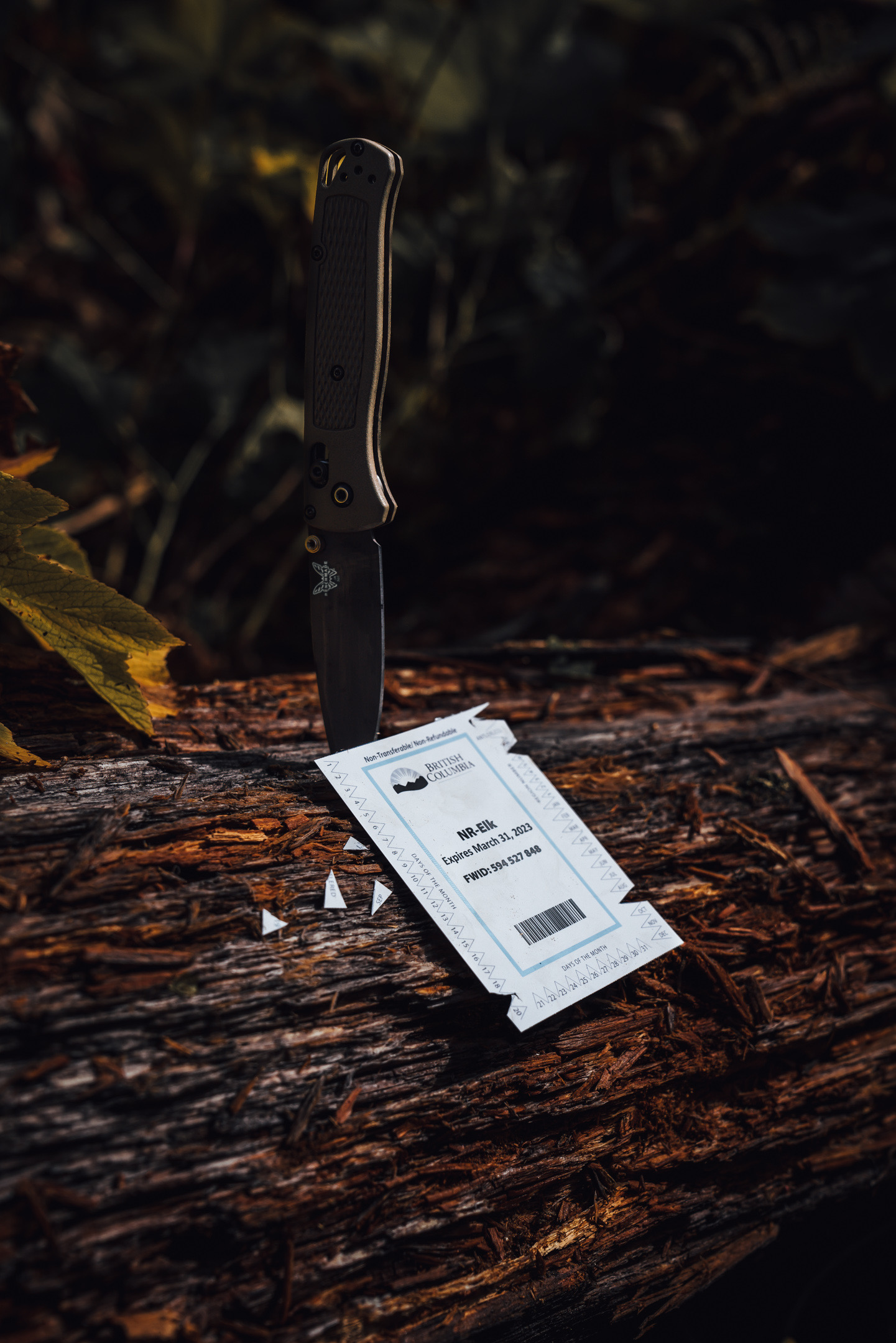
In a pinch grip or power grip, the Bugout is fantastically comfortable and the handle is deceptively detailed. The top of the handle has a slight drop from front to back. The bottom of the grip locks your index finger into place to prevent slipping and has just enough of a pinkie hook to give you extra grip. The pocket clip is reversible and the thumb studs are easy to hit with a thumb or middle finger. The axis lock makes one handed opening and closing a cinch. You can buy a Bugout with S30V, S90V, or M390 steel. All three steels are close in their toughness. M390 has the best corrosion resistance, S90V has the best edge retention, and S30V is the most affordable. -Scott Einsmann
Read our full review of the best electric knife sharpeners if you’re looking for a quick and easy way to sharpen your pocket knives.
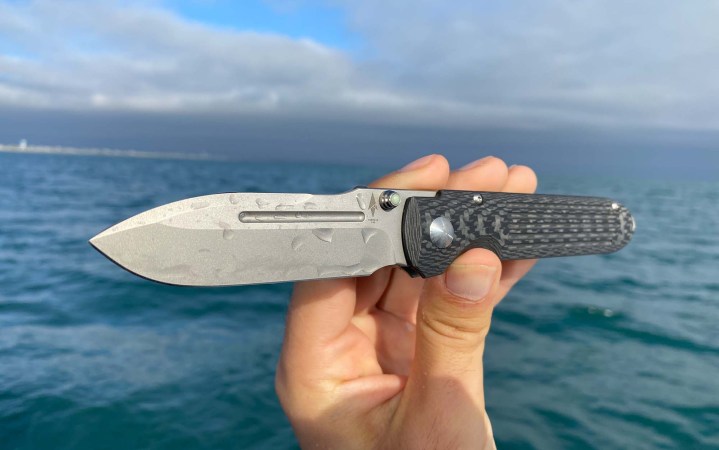
See It
Key Features
- Blade Length: 3 inches
- Steel: Terravantium
- Weight: 3.7 ounces
- Lock: Framelock
- Price: $380
Pros
- Will not rust
- Good edge retention
- Comfortable to use
Cons
- Detent is a little too strong
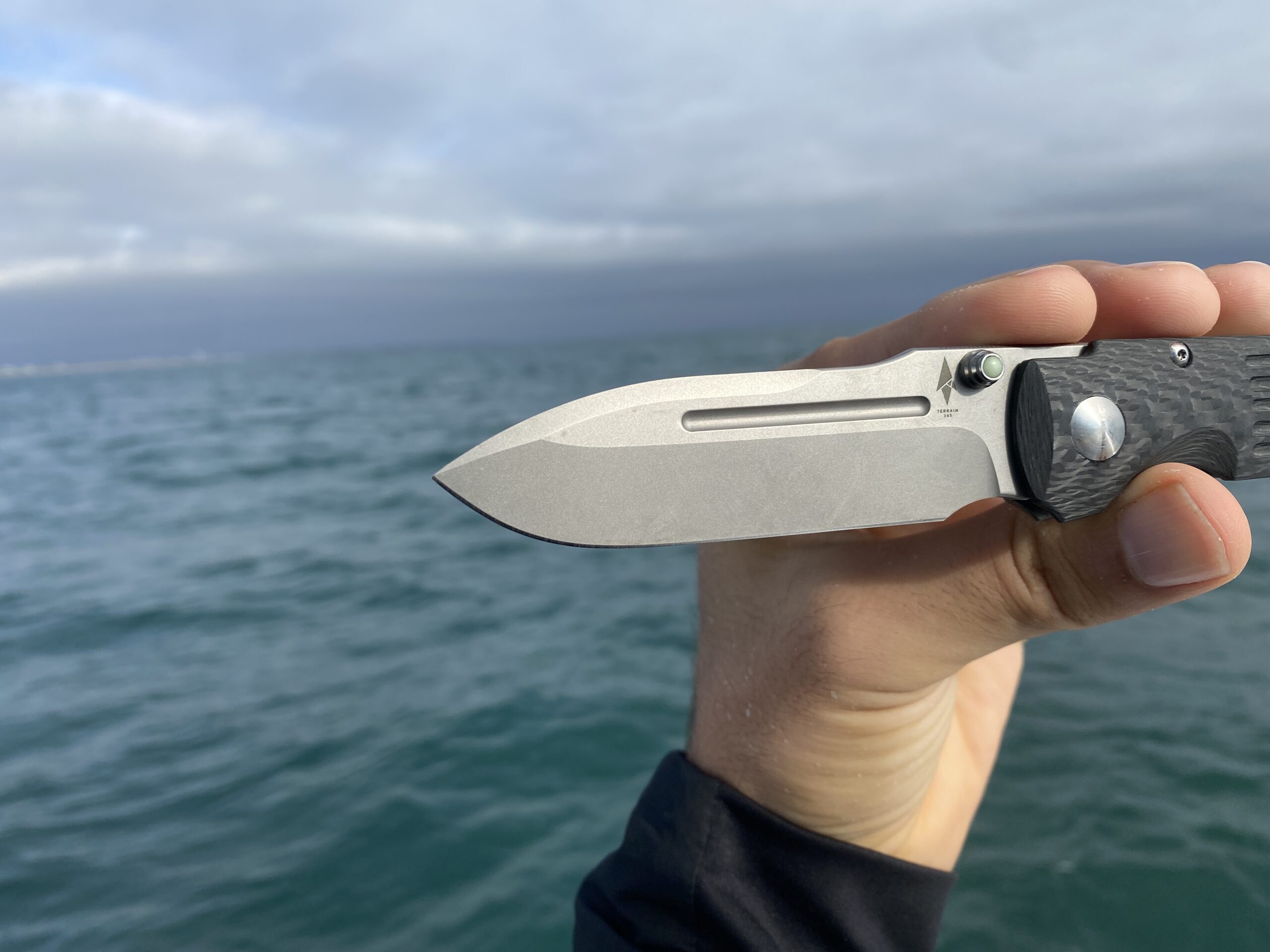
I’ve used my Invictus for EDC, hunting, and fishing this fall. I bought it because of its unique construction and I liked that every component of the knife is corrosion free. So whether I’m wet wading in saltwater or use it to field dress a deer, I don’t have to worry about rust. It has the bank vault click that’s a hallmark of a well made framelock and it rivals many midtechs for it’s fit and finish.
The blade steel used in the Invictus isn’t your typical blade steel, it’s not even steel. Terravantium is a cobalt alloy that doesn’t need to be heat treated. It’s also completely rust proof, non-magnetic, and keeps an edge for a very long time. Although I’ve found it doesn’t keep a razor edge long, it holds a toothy edge seemingly indefinitely. Mine has broken down hundreds of cardboard boxes without needing a touchup.
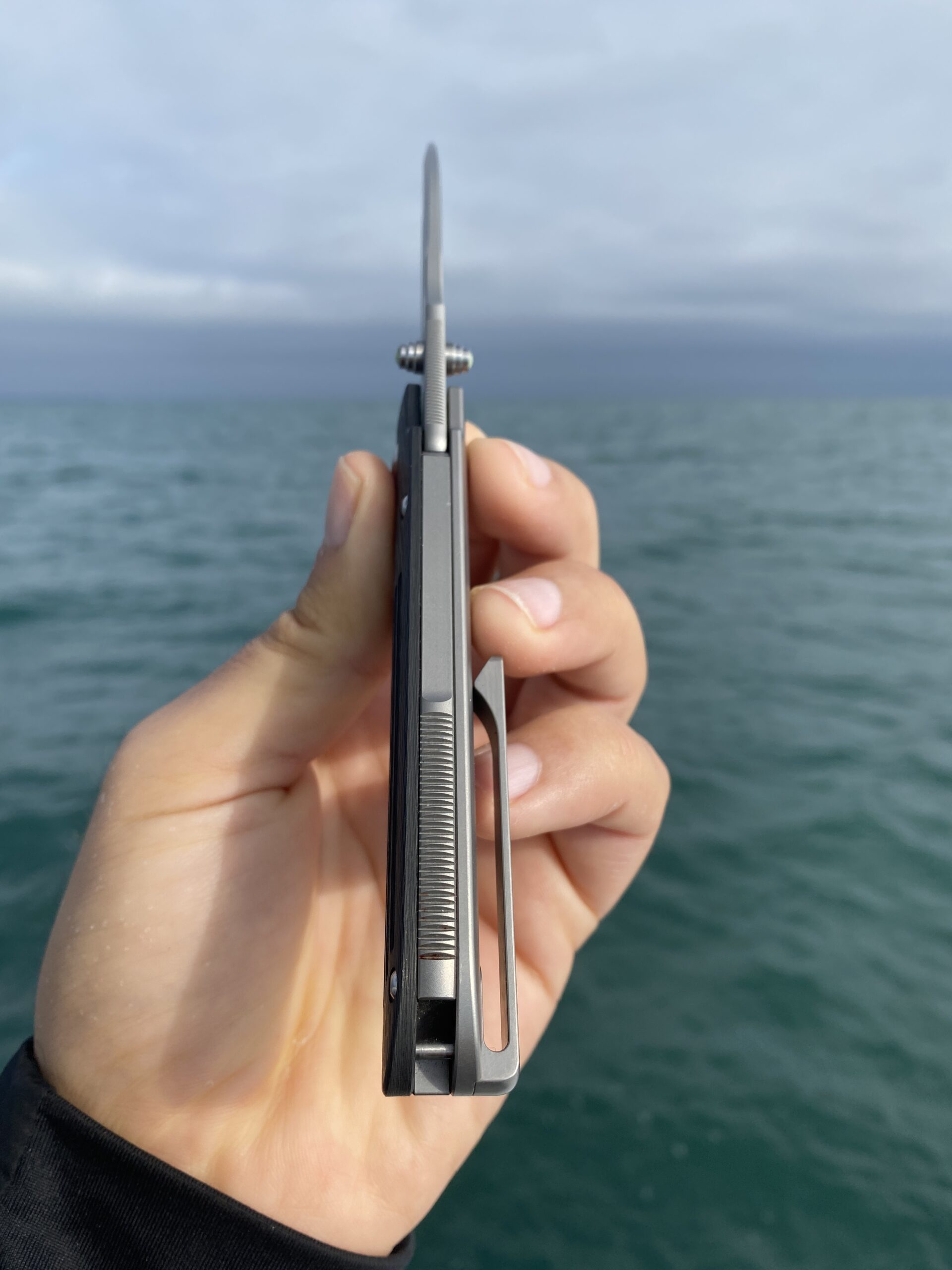
The spearpoint blade shape on the Invictus is ideal for piercing and slicing cuts. The slight distal taper reinforces the point and while I wouldn’t use it as a pry bar, it can take abuse. The ⅛ thickness is a good compromise between toughness and slicing. While the grip looks straight, it’s nicely contoured and has a deep finger choil for a secure grip in all conditions. Terrain 365 offers the knife with titanium, carbon fiber, micarta, and G10 handles. -Scott Einsmann
Best Customizable: Gerber Assert
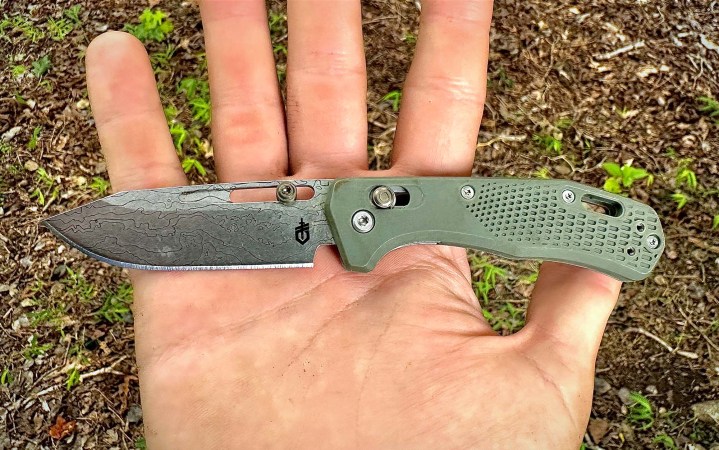
See It
Key Features
- Blade Length: 2.98 inches
- Steel: S30V
- Weight: 1.87 ounces
- Lock: Pivot Lock
- Customizable blade, handle, and hardware
- Made in USA
- Price: $175
Pros
- Easy and comfortable to carry
- One handed opening and closing
- Comfortable to use
Cons
- Not as “flippy” as some knives
With some knives, the color scheme is predetermined at the factory and you either like it or you don’t. But, the Gerber Assert is customizable in that you can choose the blade finish, hardware color, and handle color. I went with the topographic, stonewashed blade, a green handle, and orange back spacers. The process was fun and easy to do on the Gerber site, and they sent me my customized knife a few weeks later (custom orders take 12 to 15 days to ship).
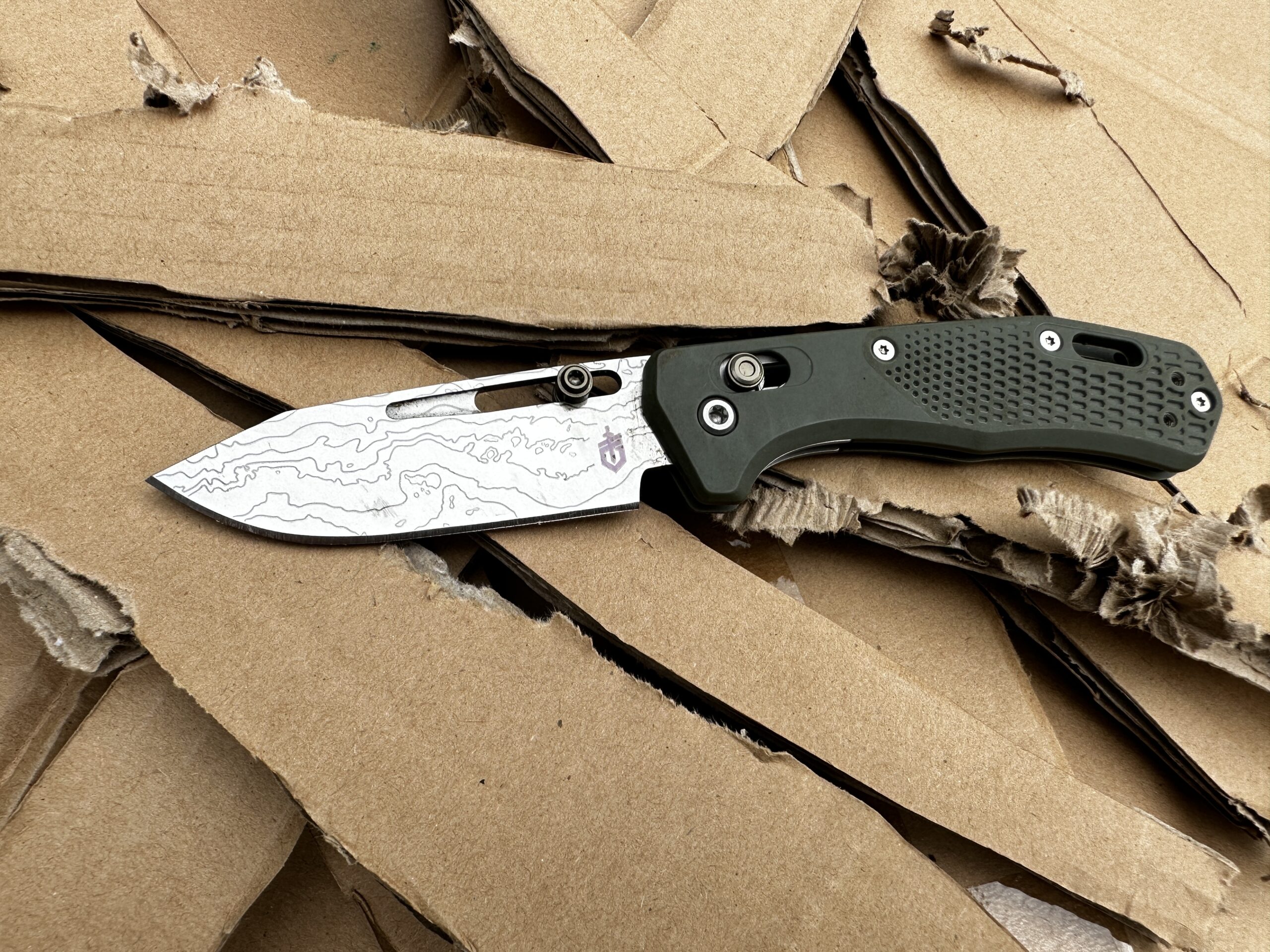
I started carrying my new EDC knife daily and put it to use opening packages, cutting twine, and harvesting vegetables from the garden. After a few weeks of use the edge was still sharp enough to push cut paper. So, I grabbed a long piece of 2-foot wide cardboard and started cutting strips. After slicing through 20 feet of cardboard the edge finally dulled to the point it couldn’t push cut paper. After two minutes on the strop it was right back to slicing though—a testament to a good heat treat.
The Assert is a comfortable knife to carry and it’s the sort of blade that disappears in your pocket thanks to its size, deep carry clip, and light weight. You can one hand deploy the Assert with the adjustable thump stud or the fuller. Although, it doesn’t fire open like some of the best flippers on the market. But if you use your knife as a tool, rather than a fidget spinner, you’ll be happy with the action.
Read Next: Best Hunting Knives
Best Slicer: Spyderco Para Military 2
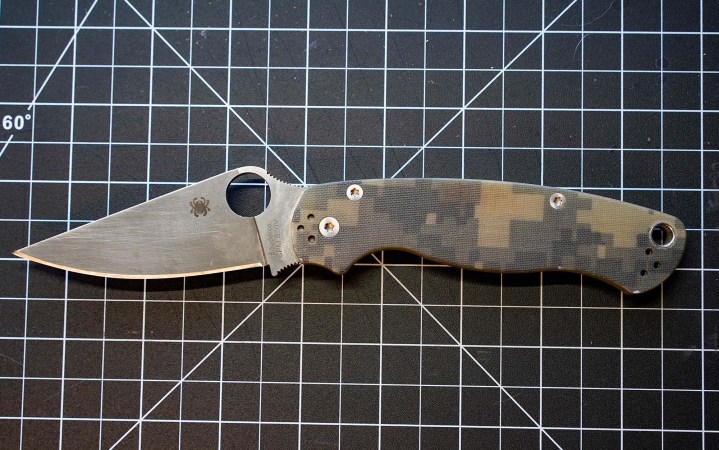
See It
Key Features
- Blade Length: 3.42 inches
- Overall Length: 8.24 inches
- Weight: 3.9 ounces
- Blade Steel: S30V (others available)
- Deployment Method: Hole
- Compression lock
- G10 scales
- Made in the USA
- Price: $180
Pros
- Lots of sharpening life
- Good ergonomics
- Lefty friendly
Cons
- Hot spots created by the pocket when in the tip down position
- Delicate tip

Some knives have a lot of hype and then they fade away, but the Spyderco Paramilitary 2 is the complete opposite of those flashes in the pan. It’s stood the test of time and continues to be a top EDC knife because as Doug Marcaida would say, “It will cut.”
The PM2’s cut time performance was good, but what solidified the PM2 as the top slicer was when I lined up the five best cutters in the test and started cutting cardboard with them. I made a cut with each and then eliminated the one that had the most resistance. I did that until there was one left standing, and to no one’s surprise the PM2 was the champ. While not surprising that it won, it was nice to confirm its legendary slicing ability.
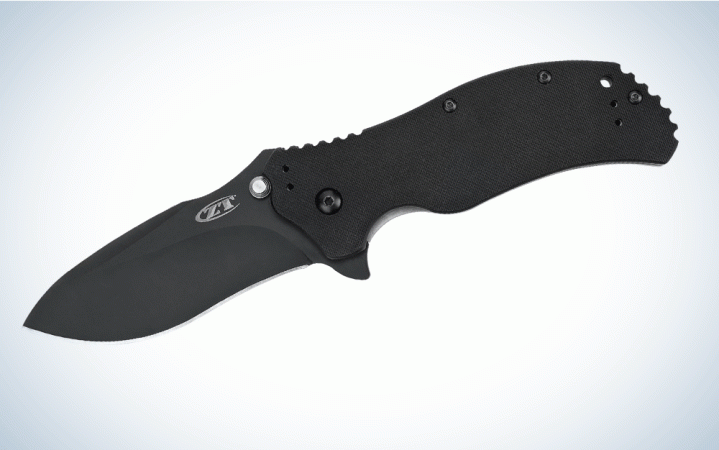
See It
Key Features
- Made in the U.S.
- 3.25-inch drop point recurve blade
- S30V steel
- Extra thick liner lock
- 6.2 ounces
Pros
- Feels like a little tank in your hand
- Lots of traction with milled G-10 and jimping where you need it
- Opens with a flipper tab or thumb studs
- Drop point blade shape is useful and strong
Cons
- Feels like a little tank in your pocket
- Recurve portion of the blade takes a little know-how to sharpen well
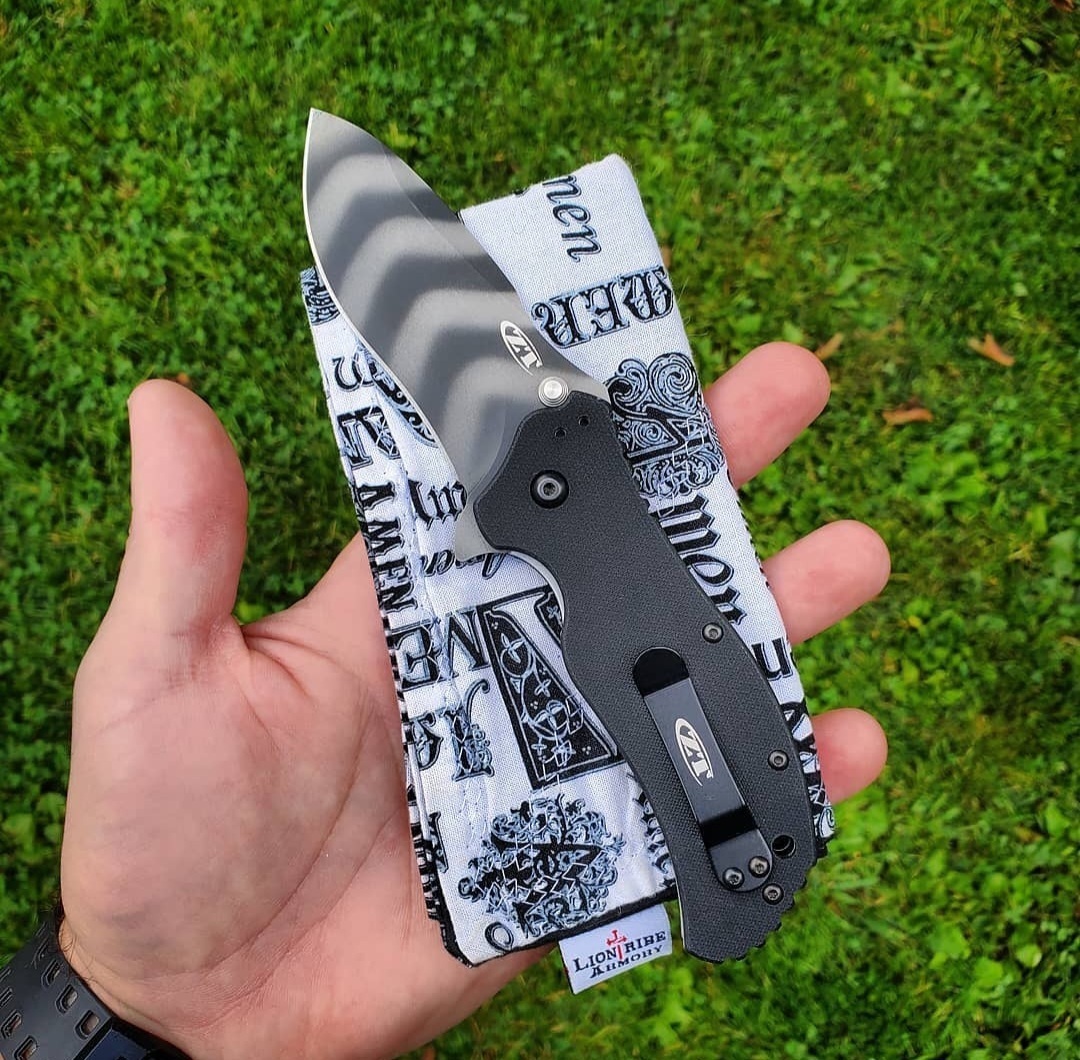
The ZT 0350 gets the nod for the best pocket knife for hard use because it’s big and tough, but not so big and tough that it’s a pain to carry. This is about the best pocket knives, after all. There are bigger and stronger hard use knives, but the 0350 is the best blend of carry and toughness. I have owned three of these over the years, and I always liked them a lot. Pretty comfy in hand, and I never felt like I didn’t have enough knife for what I was doing.
The ergonomics are designed with hard use in mind. The flipper tab doubles as a finger guard to prevent slipping forward onto the cutting edge for stabbing or thrusting cuts, which is great for a hard use knife. The blade is fairly heavy and stout, so the spring assist makes deployment much faster and easier than others that are manual opening.
Even though this blade is strong all the way out to the tip, it’s actually a pretty good slicer. Most of the time, the really overbuilt blades are prybars with semi-sharpened edges. The 0350 manages to be tough while still functioning well as a knife. ZT has a solid warranty, but it’s doubtful that you will ever need to use it. This knife is made to take some punches.
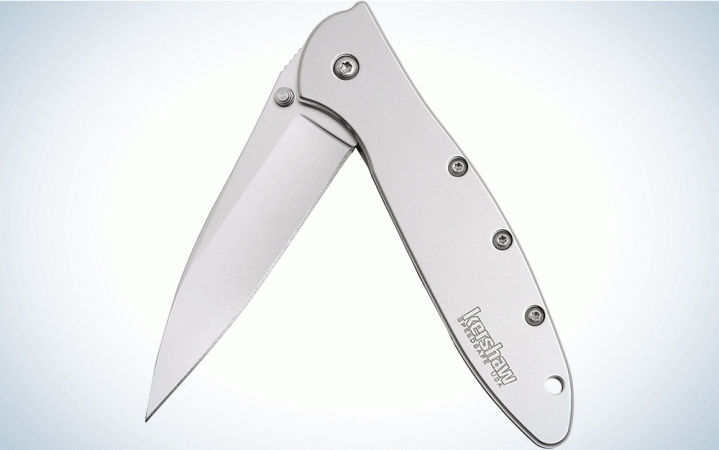
See It
Key Features
- Made in the U.S.
- Sandvik steel
- 3-inch Wharncliffe-style blade
- Liner lock
- 3 ounces
Pros
- Fast and reliable Speedsafe spring assist mechanism
- Compact design fits in any pocket
- Blade lock can be used to prevent accidental opening
- Can use flipper tab or thumb studs to open blade
Cons
- No option for left-handed carry
- Can feel a bit small for larger hands
The Kershaw Leek’s features make it the best assisted opening pocket knife. The blade is light, so it zips out lightning fast and with a satisfying snap. It’s everything that an assisted opening knife should be: fast, reliable, and safe. Another plus is the Speedsafe System that Kershaw uses does not qualify as an automatic knife, so it’s legal almost everywhere.
The Leek is compact, but feels solid, and is quite strong thanks to the stainless steel handles. The Sandvik 14C28N steel may be a bit of a tongue twister, but in my experience, Kershaw does a very good job on the heat treat and gets solid performance from this steel. Kershaw makes quite a few good assisted knives, and I almost chose the Kershaw Blur for this category, as it’s another fantastic assisted knife, but I am partial to the Leek’s styling and slightly faster deployment.
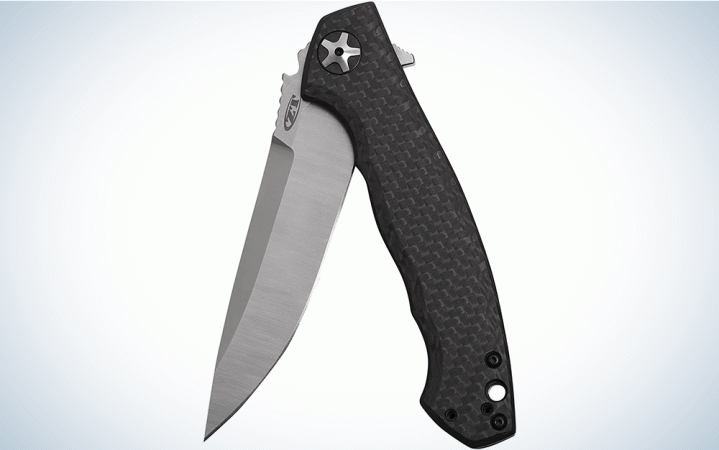
See It
Key Features
- Made in USA
- 4.1-inch drop point blade
- CPM-S35VN steel
- Titanium Frame Lock
- 4.4 ounces
Pros
- Premium materials including titanium, carbon fiber, and powdered steel
- Super smooth action using caged ball bearings (KVT system)
- Comfortable ergonomics
- Way more blade than you expect
Cons
- Way more blade than you expect
- Right-hand carry only
The ZT 0452CF will spoil you with its super smooth ball bearings and perfect detent that give it an amazing flipper action. It will be hard to look at your other knives the same way after you flick this blade open. The stonewashed titanium and carbon fiber add good looks to the mix, and premium touches like a lock bar insert and milled pivots put this pocket knife over the top.
In hand, the 0452CF feels very nice and comfortable, and the blade shape lends itself to being good at nearly every EDC cutting task you will come up against. The first time you open this knife, you will be amazed at the blade length. My initial impressions were that it was a pocket sword. But it was also very controllable, and didn’t feel like a bigger knife.
A deep carry pocket clip keeps things discreet at the office, and no one will know you’re packing a blade that’s over 4 inches because the contoured titanium and carbon fiber help this disappear in pocket with a relatively narrow and slim form factor. And let’s face it: a gentleman should make a quiet statement, and this knife certainly does that.
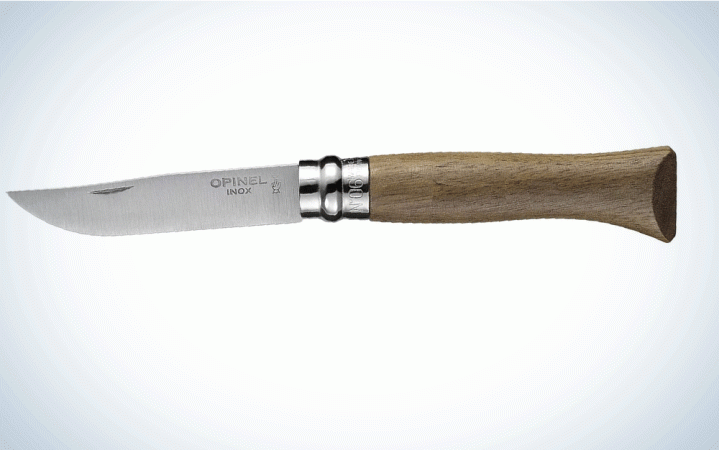
See It
Key Features
- Made in France
- 2.9-inch blade
- Stainless or carbon steel
- Easy-to-use lock
- Beechwood handle
- Only 1 ounce
Pros
- Rotating collar-style lock easy to use for smaller hands
- Wooden handle and frame can be painted, colored, carved, or burned
- Comfortable handle shape
- Inexpensive
Cons
- Carbon steel blade can rust if left out in the elements
Opinel makes a wide variety of sizes from around two inches all the way up to over 12 inches, but the No.6 is the “just right” size for a new knife user. The rotating collar lock (Virobloc lock) can be used to either hold the blade open or lock it shut. My daughters found that it was the easiest lock style for them to use. The lock on this knife does not automatically engage, which helps new knife users to slow down and think about everything they are doing. Also, fingers are never in the path of the blade while closing, which is a plus over styles such as liner and frame locks.
Let’s face it, sometimes kids lose stuff, and at well-under $20, you won’t be heart-broken if it gets misplaced. To avoid my daughter’s from getting misplaced, I drilled a hole in the back for a lanyard then attached it via a carabiner to her backpack. The Opinel No. 6 is super lightweight, customizable, comfortable, and easy to use, which makes it the best pocket knife for kids to learn on.
Best Tactical Knife: Emerson Mini CQC-15
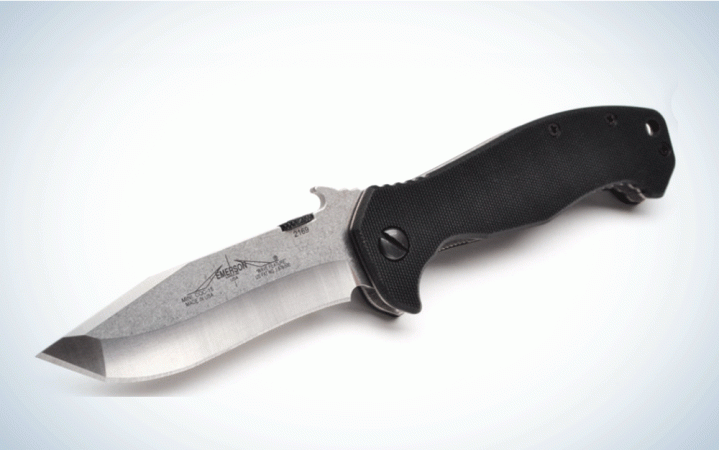
See It
Key Features
- Made in the U.S.
- 3.5-inch blade
- 154CM steel hybrid tanto/recurve blade
- Titanium liner lock
- 4.5 ounces
Pros
- Wave feature on the blade catches the edge of your pocket to open the knife upon exit
- Chisel sharpened for easy field care
- Pivot adjustment can be made with a coin
- High traction milled G-10 handle scales
- The 154CM steel is relatively easy to sharpen, but holds an edge well
Cons
- Wave feature has potential to catch other objects in pocket and partially open, though rare
- Right-hand carry only—left-hand carry option costs additional $25 from factory
The Emerson Mini CQC-15 is the best tactical pocket knife that can pull double duty as an EDC blade. The “Wave” is Emerson’s signature feature. It catches on your pocket as you pull the knife out and automatically opens the blade.
The high-traction finish on the handle and deep finger choil/guard make for a very secure grip, but isn’t comfortable for prolonged use. Another signature feature is the chisel grind, where the edge bevel is only ground in from one side. The idea is that it could be sharpened on a rock in the field more easily than a traditional double-sided bevel. I haven’t tried sharpening it on a rock, so I can’t verify. The bottom line is that while many knives dabble in the tacti-cool realm, the Emerson is an actual tactical blade. There is a reason that the Emerson blades are popular in Military and LEO circles.
Read Next: Best Self Defense Knives
Benchmade 940
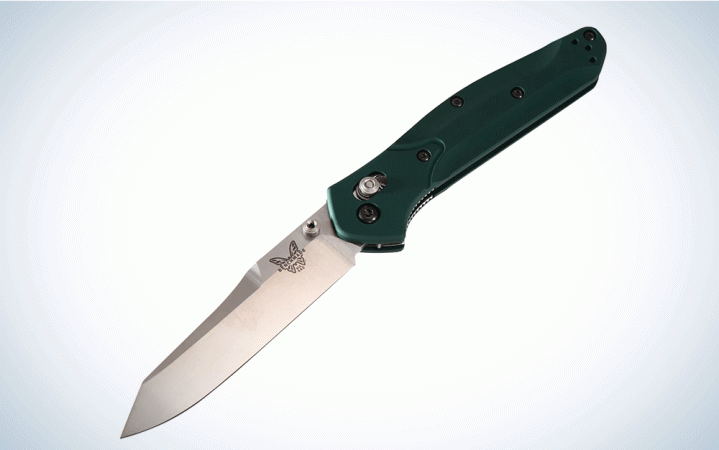
See It
Key Features
- Made in the U.S.
- 3.4-inch blade
- S30V steel
- Ambidextrous AXIS lock
- Aluminum and titanium handle
- 2.9 ounces
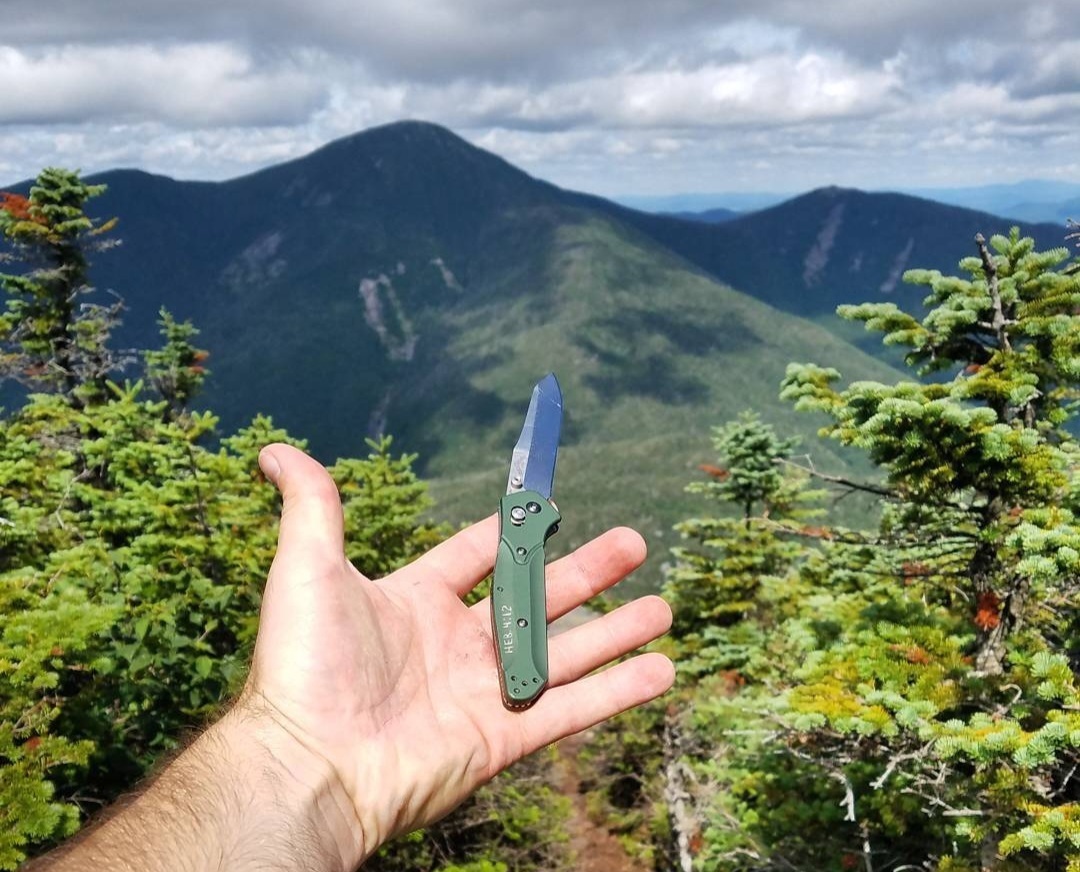
Pros
- Top-notch warranty and customer service
- High-end materials in both handle and blade
- Easy to carry and quickly deploy
- Blade design gives a strong tip for hard work
- Smaller form factor makes carrying easy for any attire
Cons
- Finish on aluminum feels “chalky” until its broken in
I have referred to the Benchmade 940 Osborne as the “Mary Poppins of pocket knives” because it’s practically perfect in every way. This is obviously subjective, but many knife nuts share my opinion. Comfortable, easy to carry, nearly impossible to kill, and backed by a company that stands by their product. For example, if you manage to bend the clip, Benchmade will send you up to three per year free of charge. Most companies don’t match that. They will also sharpen it for free for life.
Its lock design makes it easy to use with either hand, even with gloves o n. Add to that a long blade-to-handle ratio, and modest form factor in your pocket, and you have a winner. I have been beating on mine relentlessly for about eight years, and it shows no signs of slowing down. The Benchmade 940 was an easy choice for the best EDC Pocket Knife.
Read Next: Benchmade 940 Review
The Best High-End Pocket Knives
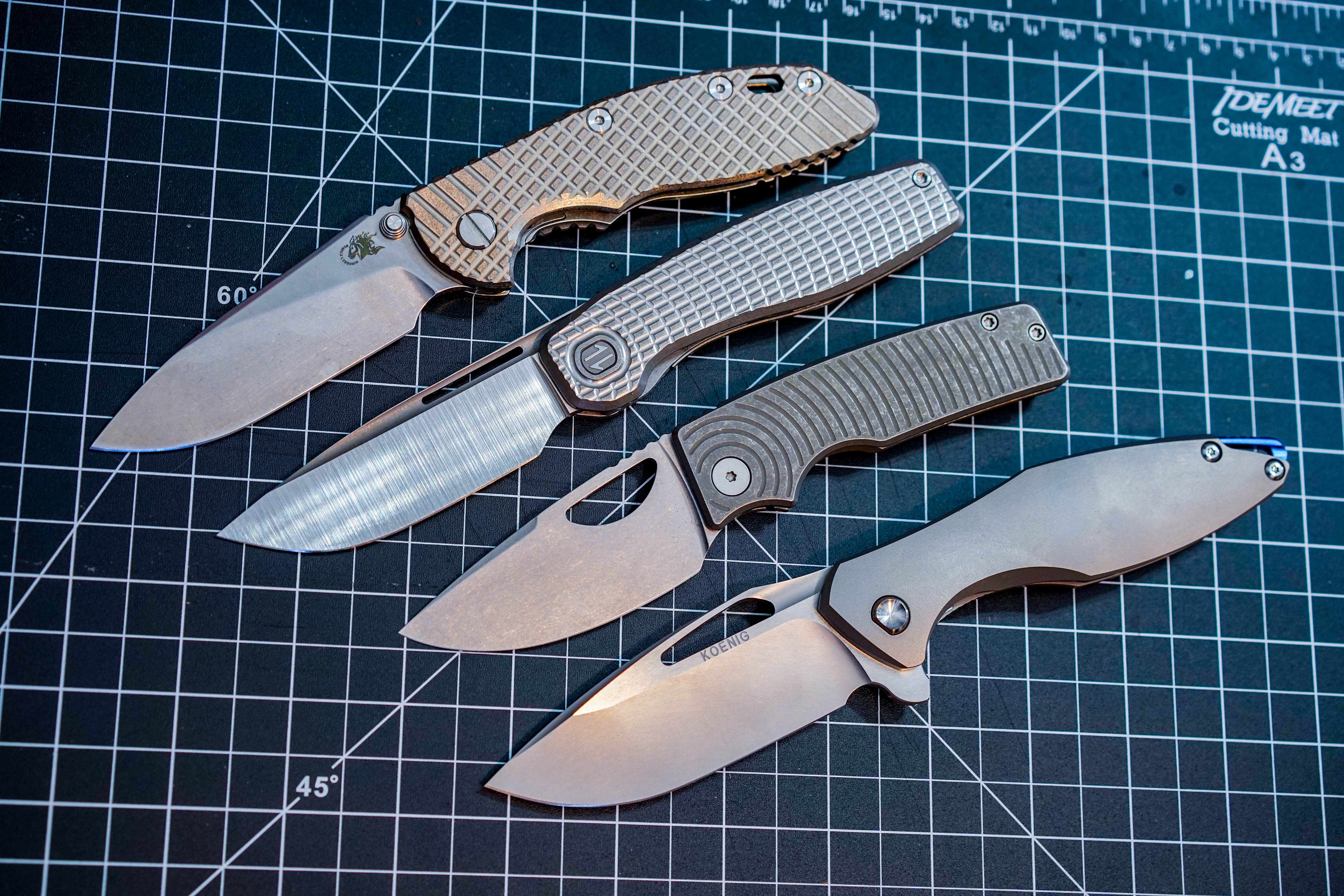
Scott Einsmann
Oz Machine Co. Roosevelt
The Roosevelt isn’t a knife that’s meant to sit in a drawer or be handled with white gloves. It has a utilitarian finish and it’s been designed specifically to be carried. Keep that in mind if you’re looking to pick one of these up.
I put my Roosevelt through the cut test and it did great, but it didn’t blow the other knives out of the water. It’s a knife with a full-flat grind and a good blade shape—it’ll cut stuff. Where it shines is its incredible ergonomics, engineering, and build quality. The grip was the most comfortable and secure I tested. The amount of blade and handle the Roosevelt has for its folded size is an engineering marvel. It’s also incredibly light for its size. Of course, the build quality is top notch and it has an elite-level action.
If price and availability weren’t a factor, the Roosevelt would be my pick for the best EDC knife. I don’t think there’s a better designed and built knife for daily carry available. But, you just can’t get them without paying a ton or getting lucky on a drop.
Brown Knives Mini FSD-I
If you want an expensive folding knife with instantly recognizable quality, the FSD-I is your knife. It looks and feels high end without being gaudy. The action is the best I’ve experienced and it goes beyond being just smooth—it’s a controlled, hydraulic like smoothness. The detent is just strong enough for the blade to fire out with a reverse flick or the front flipper, but it’s not so strong that you can’t smoothly roll out the knife with your thumb. The machine work is impeccable and there are a lot of neat machining Easter eggs to find. As pretty as the knife is, it’s still a tool and it cuts very well thanks to its hollow grind.
Hinderer XM-18
I get that Rick Hinderer can be polarizing, but there’s no denying his company makes a superb overbuilt folder. The XM-18 is my favorite knife in this class and I think it lives up to the hype. For EDC the 3-inch, non-flipper variant is my top choice. I carry the 3.5-inch non flipper, which is also a great choice if you don’t mind its size.
Koenig Arius
The Arius is like the FSD in that it looks and feels like a quality knife. The flipper action is insanely good, but it’s kind of a one trick pony. My knife’s detent is a little too strong for a reliable reverse flick and it doesn’t roll out for the same reason. The pocket clip on mine is also too tight and I can’t fully clip it onto jeans. Yet, it’s still one of my favorite knives because of the deep hollow grind, great looks, comfortable ergonomics, and fun flipper action.
Things to Consider when Choosing a Knife
There is a lot to look at when choosing the best pocket knife in any given category. In the world of pocket knives, options range from $5 to $5,000. There are knives with blades that are under an inch up to nearly a foot. Blade steels range from barely better than a chunk of angle iron to the latest super-steels. Here are a few tips on how to sort through a variety of blades and find the right pocket knife for you.
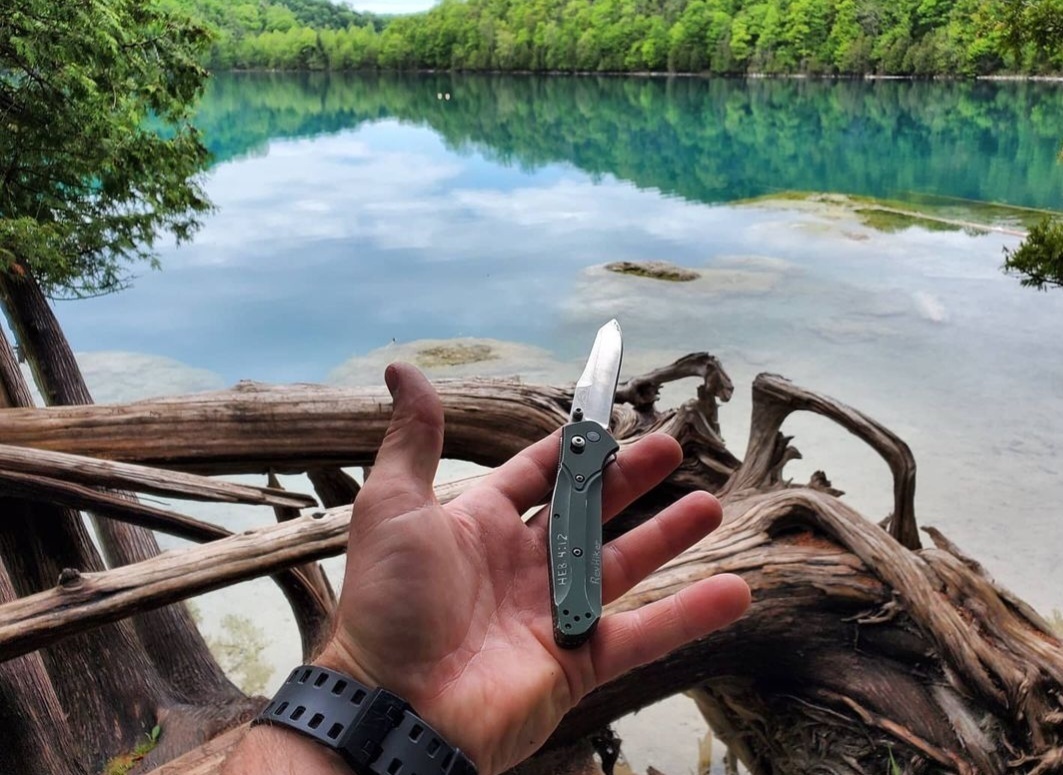
The first thing you want to determine is what you intend to use the knife for. For example, a hard use knife has a much different intended use and environment than a kid’s first knife. One has to be able to pierce, pry, and have maximum grip, and one has to be light and easy to use and really only stand up to the abuse of whittling a stick. While considering how you’ll use your knife, realize that features come at a trade-off. For example, you can have a knife that slices well like the PM2, but it won’t be as durable as a thicker blade like a Benchmade Adamas.
Read Next: Best Survival Knives
Another big consideration is how easy the knife is to carry. For me, this is a big one. The shape and size of the knife, when closed, have the biggest effect on this. If I can’t get my hand past my knife to get other things in my pocket, that’s a real concern. Pocket clips also make a difference in how the knife rides and carries, and their designs are more important than you might think.
Finally, look at the blade steel. I have owned knives that performed and carried well, but the steel was lacking. That meant I was constantly sharpening it, or it was so hard and brittle that I was always fixing chips. Some steel is super easy to sharpen but won’t hold an edge, and some steel will cut forever, but take you an eternity to sharpen. The ideal steel finds a happy balance between the two. Also, avoid blades with ambiguous labels like “surgical stainless.” There’s a lot to learn about blade steels, but I think it’s worth the time investment.
FAQs
Knives on this list of best pocket knives range from less than $20, to well over $200. I have found that knives priced from $100-$250 usually offer the most for your money (with a few exceptions). You will generally get very good quality, good blade steel, well-thought-out design, good warranty, and a lot of trouble-free use.
This depends heavily on the intended use. Some applications require pure edge retention, while others favor steel with more toughness (resistance to breaking). For general use, S30V is a great steel that will hold an edge well, and will also sharpen up without too much trouble. It’s miles better than most blades steel out there, but it’s not a hard-to-sharpen and expensive super steel either.
Knife laws are sometimes complicated and arbitrary. Check with your local jurisdiction to be sure the type of knife you want is legal in your area. Knifeup.com and akti.org (American Knife and Tool Institute) both have large databases for state and local laws.
Top pocket knife brands include Benchmade, Spyderco, CRKT, Buck, Kershaw, Case, and Zero Tolerance.
Read Next: The Best Camping Knives of 2023
Final Thoughts on the Best Pocket Knives
I have been hooked on pocket knives since my dad gave me a Swiss Army Knife at age 5. Having a knife opened a world of possibilities to me at that time, and to this day, a pocket knife is an essential tool that I am never without.
The best pocket knives on this list have all been vetted, tested, and proven. Picking up any one of them will be a great addition to your collection or the perfect springboard to launch you into a knife addiction, I mean, hobby. Think of your knife as a tool: pick the tool that will best suit the work you are doing, and it will be the best pocket knife for you.
Read the full article here

